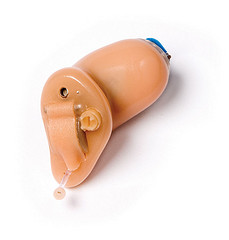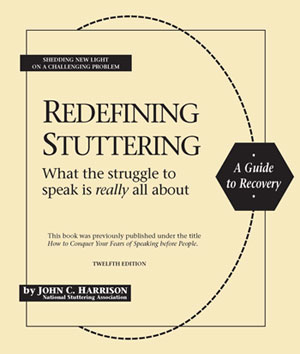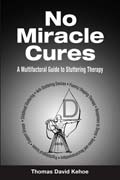The SpeechEasy is a small “anti-stuttering” device that uses hearing aid technology to deliver Delayed Auditory Feedback (DAF), and, Frequency Altered Feedback (FAF), to a person who stutters. DAF and FAF have been found to reduce stuttering to varying degrees. The SpeechEasy technology is based on the phenomenon that when a person who stutters, speaks or reads in unison with another person, then they do not stutter in the majority of cases. This phenomenon is known as the “choral effect”. DAF plays the person’s own voice back to them, and they hear it with a slight delay, usually about one tenth of a second later. FAF alters the frequency of the feedback that the person hears. It can be set at a high frequency, where the person hears a higher pitch voice, or a low frequency, where the person hears a lower pitch voice in their ear.
 In this two part post, I would like to tell you about my personal experience with the SpeechEasy device. In the first part, I would like to tell you about some of the general pros and cons of the device, and in the second part, I will tell you how it is working for me.
In this two part post, I would like to tell you about my personal experience with the SpeechEasy device. In the first part, I would like to tell you about some of the general pros and cons of the device, and in the second part, I will tell you how it is working for me.
Although I have tried most stuttering treatment techniques, I have always preferred to use Prolonged Speech as my stuttering control method, and have always had great success with it, although it requires a lot of ongoing work and concentration, to maintain fluent speech. When I first used the Speech Easy, I found that I was able to obtain effortless fluency. Although I was using elements of my fluency shaping technique, I did not really have to use those techniques, to be fluent while I was wearing the SpeechEasy. All I had to do, was listen to the delayed feedback in my ear as I was speaking, and a good degree of fluency ensued, without a great deal of effort.
The SpeechEasy device that I was using, was what is called an, In The Ear device. It could not be seen from the front or the rear, but could be seen from the side, however, having said that, it was relatively low profile. As a result I did not have any concerns about wearing it. I also made everyone at work aware that I had this new device, so that I would not be concerned about what they might be thinking of me wearing what appeared to be a hearing aid.
I would insert the device into my ear in the morning as I left for work, and I would remove in when I walked back in the door at the end of the day, so I guess you would say that I, “did not leave home without it”, and used it constantly. The reason for this is that I had a high level of fluency when I was wearing it, and an unacceptable level of fluency when I took it off. So I guess what I am saying is, that I did not have a great deal of carry over fluency when I took the device off, as some people had told me I may get.
Although I was not totally fluent when wearing the SpeechEasy, I was not blocking greatly, and when I did block, it was only for a fraction of a second, then I was moving again. I felt liberated from stuttering, and liberated from the fluency shaping approach that I had constantly worked on for many years. I found that I was pretty much able to speak to anyone in any situation while I was wearing the device, and my freedom to move around in all speaking situations was expanded greatly. There were however, some drawbacks to using the device that I discovered, and although some of these drawbacks were significant, they did not outweigh the benefits that I gained from constantly using the device.
So what were these drawbacks, and how significant were they? Let me go through these one at a time:
Comfort – Although the SpeechEasy was custom fitted for my ear canal, I was glad to take it out at the end of the day, as it can be uncomfortable at times, but having said that, this was not a great problem.
Battery – Although the battery of the SpeechEasy lasts a very long time, the device does not give you a warning when the battery is about to expire. I often found myself in the middle of an important meeting or conversation when the battery would suddenly run out. This was very disconcerting when it first happened, and was a reason for an element of panic on one occasion, however, a quick battery change is not too difficult (if you carry a spare), as long as you have an In The Ear version of the device, and not a Completely in the Canal version, (see below).
Background Noise – By far the biggest drawback of the SpeechEasy is background noise. When the SpeechEasy device is inserted into the ear and turned on, many of the ancillary noises around you tend to be amplified. The clinking of knives and forks in a restaurant, or the roar of a car that passes you in the street, all are amplified. You can lower the volume if you are not about to speak, but when you are speaking to someone, while all these ancillary noises are happening around you, it can be very difficult sometimes to hear what the other person is saying. One notable situation where I found it almost impossible to hear what the other person was saying, was when I was in a crowded restaurant having breakfast with some strangers. I had the device in my left ear. I could hear what the person on my right was saying, but when the person on my left spoke, there was so much background noise of clinking plates and cutlery, that I was not able to hear what the person was saying, and because I was sitting at a large round table with the person next to me, I was not able to turn my right ear towards that person, to make the listening easier.
Constant Altered Feedback – The altered feedback on the device is voice activated, which means, when you are alone the device will not activate unless you speak, or a noise is made. Now this is great in a situation where you are say at home alone, or in your private office at work, but when you are in the company of another person, or in a crowded room, everything that you hear through the ear that has the device in it, will be heard in the altered auditory settings, that you have programmed into the device. That means that the other person will be heard in the slightly delayed setting that you have, which is not so bad, but if you have your device set to include frequency altered feedback (FAF), then everyone sounds like Darth Vader or Mickey Mouse, depending on the setting that you have chosen.
Obsessed Dependence – Unlike fluency shaping skills that you carry with you in your head, the SpeechEasy device is an object, and as such it can easily be forgotten or worse still, lost or broken. I had a friend of mine who was so attached to his device, that he had a mild panic attack one day when he realised when he got to work, that he had forgotten his device, and had to rush back home and get it before he could front work for the day. His round trip home and back to the office took him 45 mins. Another friend misplaced his device for a week, and as a result suffered extreme anxiety for that week.
Fragility – The SpeechEasy device is a very fragile piece of technology. If you accidentally drop it on the ground and step on it, it will shatter. If you shake it around excessively, the soldered connections inside can break. The battery can shift inside the battery compartment and stop the little battery compartment door from coming open. If you have to force the battery door open, you can break it, and the battery will not stay in the device. If any of these things happen, the device needs to be sent back to the manufacturer for repair, which can take 2 – 6 weeks, depending on where you live.
Tinnitus – I don’t know if this was just peculiar to me, but after wearing the device constantly for 3 months, I began to develop a slight level of tinnitus or ringing in the ear, which is still there to this day. Adverse to Speech Fluency Skills – Although I was told that my fluency using the device would be enhanced by combining it with my fluency shaping skills, I found that I had difficulty applying those skills, when I was using the device. My friends who also used the device, said that they found the same thing. This was not so bad when I was wearing the device, as I did not need to use my fluency shaping technique to a great degree to be fluent, but when I took it off, the fluency technique was not there for me, and I would begin to stutter with greater severity.
Volume Adjustment – As mentioned, I have an In The Ear (ITE) device, which can be seen quite easily by others that I am wearing a hearing aid. That did not bother me greatly, however, others choose to purchase a Completely In Canal (CIC) device, as it cannot be seen. On my device there is a little dial that allows me to switch it on and off. as well as adjust the volume. In addition, there is a little button that allows me to switch between one of two preset programs, like FAF/DAF or standard DAF. It is very handy to be able to make these adjustments without removing the device, however, if you have purchased a CIC device, you are not able to make any adjustments without removing it, which is not practical.
In Part 2 of this article, I will answer the questions on every bodies lips, which is, am I still using the SpeechEasy and, if so, has there been any deterioration in the effect of my fluency enhancement. In the meantime, I again urge you to subscribe to my RSS feed or email notification, so that you do not miss posts about subjects and content that you will not read anywhere else. If you found this post useful or thought-provoking in any way, please make a comment.
Comments:








{ 2 comments… read them below or add one }
THANK YOU so much :))
Do you know any one that has tried myspeech? Or do you know where I can find myspeech reviews? I do not have a severe case of stuttering. I mostly stutter where i have to do public speaking which i often do because of my work. I need